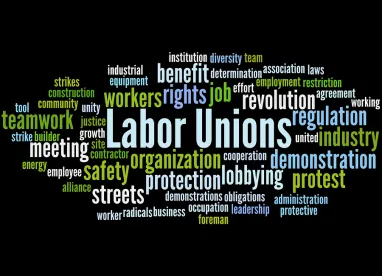On June 5, 2020, the NLRB held, in Teamsters Local Union No. 735-S (Bemis Co., Inc.), 369 NLRB No. 97, that union officials’ retaliatory actions against members who participated in an investigation resulting in the discharge of the union president violated the NLRA’s prohibitions against union restraint or coercion (Section 8(b)(1)(A)) and causing employer discrimination (Section 8(b)(2)).
Factual Background and ALJ Decision
The employer manufactures bread bags and its production, maintenance and warehouse employees are represented by a union. In mid-December 2017, an employee reported to the employer that a fellow employee, who also happened to be the union president, had verbally harassed a third employee for more than a year. Bemis suspended the union president and conducted an internal investigation, interviewing employees, including two union members, one of whom was the allegedly-harassed employee. The employer concluded there was merit to the allegations and discharged the union president the following month.
Starting shortly after the investigation was launched, union officials engaged in efforts aimed at maintaining a code of silence among its members. First, the secretary-treasurer approached the allegedly-harassed employee in the breakroom and yelled at him, promising to conduct her own investigation. The secretary-treasurer then posted a memo stating in part:
“We as [ ] Union Brothers and Sisters do not turn each other in if we have an issue[] we go to a steward or a board member. Turning in fellow Union members is a violation of the Union by laws and could result in fines and [sic] black listed from all union jobs.”
Next, when one of the other participants in the employer investigation mentioned to the union vice president that he had been receiving notes and items that resembled rats, the vice president responded by threatening the employee with reprisals.
Finally, the secretary-treasurer lodged multiple safety-violation complaints with the employer against the allegedly-harassed employee for not wearing ear protection on one occasion, and for failing to wear proper protective gear when cutting pizza with his work knife on another occasion.
The ALJ found the union’s posting of the memo and the statements made by the union vice president violated Section 8(b)(1)(A) of the NLRA, but dismissed the claims against the union for the secretary-treasurer’s actions in yelling at the allegedly-harassed employee in the breakroom and attempting to have the employer discipline the allegedly-harassed employee for the two safety violations.
All of the Cited Actions Violated the NLRA, According to the Board
The Board affirmed the violations found by the ALJ, but the Board reversed the ALJ’s dismissal of the complaint allegations against the union secretary-treasurer. Section 8(b)(1)(A) of the NLRA makes it unlawful for a labor organization or its agents “to restrain or coerce employees in the exercise of the rights guaranteed them in Section 7 of the Act.” Section 8(b)(2) makes it unlawful “to cause or attempt to cause an employer to discriminate against an employee.” The Board considered whether the union secretary-treasurer’s actions against the allegedly-harassed employee violated either provision of the Act. As an initial matter, the Board found that the allegedly-harassed employee’s participation in the employer investigation of the union president was protected activity.
The Union Official’s Threats and Harassment Violated Section 8(b)(1)(A) of the Act
As to the allegation that the union secretary-treasurer yelled at and threatened the allegedly-harassed employee in the breakroom, the Board reversed the ALJ and found a Section 8(b)(1)(A) violation. The test for finding an unlawful threat in violation of 8(b)(1)(A) is “whether the remark can reasonably be interpreted by the employee as a threat.”
Here, the Board found that the accusatory language, the close proximity the union official got to allegedly-harassed employee, the official’s gestures, and the official’s promise to “get to the bottom of it,” warranting a finding that such actions could reasonably be interpreted as a personalized threat to hold the allegedly-harassed employee accountable for his role in the union president’s discipline. The Board added that while the union had the right to investigate any disciplinary proceedings against an employee, the secretary-treasurer’s actions crossed the line and could not be framed as a general expression of the intent to investigate.
The Union Official’s Attempts to Cause the Employer to Impose Discipline Violated Section 8(b)(2) of the Act
The Board then addressed the secretary-treasurer’s attempts to have the employer discipline the allegedly-harassed employee. A union violates Section 8(b)(2) of the Act if it has “caused or attempted to cause discrimination if there is sufficient evidence to support a reasonable inference of a union request or a union-employer understanding.” An implied request that an employee be disciplined will suffice.
Here, the Board found the secretary-treasurer’s course of conduct was done with a singular goal: “having the Employer take formal disciplinary action against [the allegedly-harassed employee].” Having made this threshold conclusion, the Board then considered whether the union’s actions were unlawful by applying the burden-shifting framework of Wright Line, which requires a showing that 1) the employee engaged in protected activity, 2) the union had knowledge of the activity, and 3) the union bore animus towards the employee, for an 8(b)(2) violation. The Board concluded that all three requirements were present here, and then shifted the burden to the union to show it would have taken the same action absent the protected activity. The union failed to satisfy its burden, with animus highlighted by the secretary-treasurer’s threats against the allegedly-harassed employee, the multiple “safety” complaints lodged against the employee for minor infractions, and the “blacklist” memo.
Finally, the Board analyzed the conduct under the duty-of-fair-representation framework. There, a union may rebut the presumption that it acted unlawfully after causing or attempting to cause an employee to be disciplined by demonstrating that its action “was necessary to the effective performance of its function of representing its constituency.” Even under this framework, the Board reached the same conclusion that the union failed to rebut the presumption of unlawful conduct stemming from the sought discipline.
Takeaways
This is an interesting case especially in current times where, more than ever, employees are encouraged to report policy violations even if they involve fellow employees. Many labor practitioners have stories where a union-represented workforce is encouraged not to report on or to participate in investigations against fellow bargaining unit members. This can be significant especially in cases of safety violations or harassment.
Here, the Board applied existing law to show that a union may not attempt to silence its members who engage in protected activity by making complaints to their employer through disciplinary threats or other acts of reprisal. Not surprisingly, the Board frowns on a union’s use of threats of fines and other discipline, such as blacklisting, to prevent an employee from making a complaint to an employer, just as the Board would find that an employer violated the Act for engaging in the same conduct that infringes on an employee’s exercise of Section 7 activity. Similarly, a union may not use an employer’s policies as a “cat’s paw” to seek to discipline a bargaining unit member in retaliation for that employee’s participation in an investigation.





 />i
/>i

